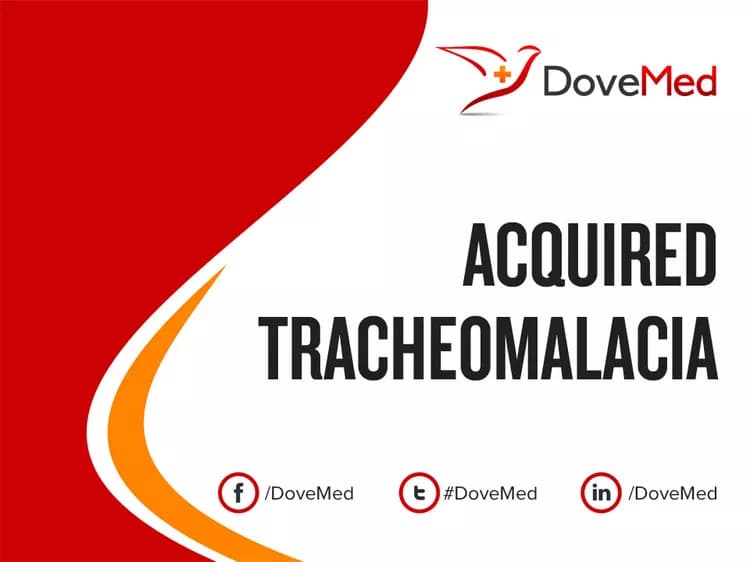What are the other Names for this Condition? (Also known as/Synonyms)
- Secondary Tracheomalacia
What is Acquired Tracheomalacia? (Definition/Background Information)
- The trachea is a hollow tube that conducts air from the nose to the lungs and vice versa. It is also known as the windpipe. In a normal child, the trachea is rigid
- Acquired Tracheomalacia is a rare disorder in which the walls of the trachea are weak and sagging, which occurs due to a structural defect, an injury, fistula, infection, or surgery
- When an adult with tracheomalacia exhales, the trachea narrows down, causing a great difficulty in breathing. The cartilage surrounding the trachea is not strong enough to hold it
- With proper treatment of the condition, Acquired Tracheomalacia may resolve. Until then a close monitor of the condition is necessary
- The prognosis is generally good, if severe complications or respiratory infections do not develop
There are two types of tracheomalacia, which include:
- Primary or Congenital Tracheomalacia
- Secondary or Acquired Tracheomalacia
Who gets Acquired Tracheomalacia? (Age and Sex Distribution)
- Adults and children both may be affected by Acquired Tracheomalacia, though it is a rare condition
- Both male and female genders are affected
- All races and ethnic groups can be affected
What are the Risk Factors for Acquired Tracheomalacia? (Predisposing Factors)
The risk factors of Acquired Tracheomalacia could include:
- Structural defects of the trachea
- Inflammation the trachea
- Tracheal infections
- Any surgery that weakens the trachea, such as a tracheostomy
- Chronic use of a breathing tube
- Trauma to the trachea
- Individuals with tracheoesophageal fistula
It is important to note that having a risk factor does not mean that one will get the condition. A risk factor increases ones chances of getting a condition compared to an individual without the risk factors. Some risk factors are more important than others.
Also, not having a risk factor does not mean that an individual will not get the condition. It is always important to discuss the effect of risk factors with your healthcare provider.
What are the Causes of Acquired Tracheomalacia? (Etiology)
The possible causes for Acquired Tracheomalacia include:
- Pressure exerted by the large blood vessels on the airways
- It can occur as a complication when surgery is performed to repair tracheoesophageal fistula or esophageal atresia
- Having a breathing tube or tracheostomy for a long time
- Due to a tumor in the throat
What are the Signs and Symptoms of Acquired Tracheomalacia?
The signs and symptoms associated with Acquired Tracheomalacia may include:
- Breathing difficulties that becomes worse with coughing, crying, or with other upper respiratory infections (like a common cold)
- High-pitched breathing (stridor)
- Noisy breathing that changes as the physical position of the child changes; it may get better during sleep
- A rattling sound may be heard when the individual breaths
- Swallowing difficulties
How is Acquired Tracheomalacia Diagnosed?
For diagnosing Acquired Tracheomalacia the following tests may be conducted:
- Physical examination (also to assess the signs and symptoms) and evaluation of medical history
- Chest X-ray: To check narrowing of the wind pipe, while exhaling
- Laryngoscopy: A procedure used to view the structure of the airway and the severity of the infection (if any present). A laryngoscopy may provide helpful information that could aid in the diagnosis of the condition
A few other tests may include:
- Airway fluoroscopy: A quick and dynamic way to study the entire airway, while examining for any laryngotracheal abnormalities
- Barium swallow is a test that is undertaken to find out the cause for difficulty in swallowing
- Bronchoscopy: It is like an endoscopy, but a bronchoscope is used to visualize the lungs and airways
- CT or MRI scan of the chest
- Lung function tests
Many clinical conditions may have similar signs and symptoms. Your healthcare provider may perform additional tests to rule out other clinical conditions to arrive at a definitive diagnosis.
What are the possible Complications of Acquired Tracheomalacia?
The complications that may arise as a result of Acquired Tracheomalacia include:
- Aspiration pneumonia: Inflammation of the lungs and airways, caused by breathing in a foreign body
- Tracheomalacia patients often have severe lung problems, despite the use of breathing machines
How is Acquired Tracheomalacia Treated?
The individual may have to be closely monitored in case any complications or respiratory difficulties are observed. A treatment for Acquired Tracheomalacia may involve the following:
- Maintaining continuous positive airway pressure (CPAP), when the airways are kept constantly open by using a mild pressure. This is recommended for patients with respiratory issues
- Use of stent: A tiny tube is inserted into the respiratory organs to keep it open
- Physical therapy for the chest
- Administration of antibiotics, to treat any infections
How can Acquired Tracheomalacia be Prevented?
Currently, there are no methods available to prevent the development of Acquired Tracheomalacia. However, the following measures can help reduce the risk Acquired Tracheomalacia:
- Treating any tracheal infections promptly
- Undertaking appropriate treatment for tracheoesophageal fistula
- Avoiding the chronic use of a breathing tube (if possible)
- Reducing inflammation in the trachea
What is the Prognosis of Acquired Tracheomalacia? (Outcomes/Resolutions)
- With the help of proper treatment, Acquired Tracheomalacia can be corrected and the symptoms may subside within 18-24 months
- The condition can be fatal, if adequate care and supportive treatment is not provided
Additional and Relevant Useful Information for Acquired Tracheomalacia:
Please visit our Healthy Lungs Center for more physician-approved health information:
Related Articles
Test Your Knowledge
Asked by users
Related Centers
Related Specialties
Related Physicians
Related Procedures
Related Resources
Join DoveHubs
and connect with fellow professionals


0 Comments
Please log in to post a comment.